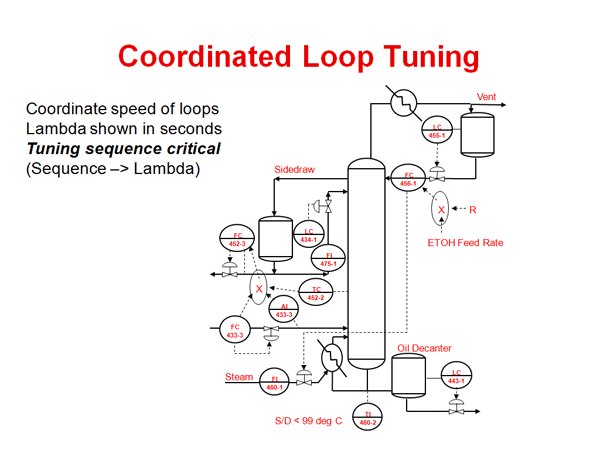Part 1 in the series addressed basic distillation column control and Part 2 explored inferential composition measurement and control design. In today’s post I share how we need to consider how to close the material balance and the application of advanced process control (APC).
Material Balance
The level in the reflux accumulator is affected by boil-up, reflux flow, and distillate flow. Generally boil-up is used to control the bottom composition, but it is possible to use it to control the reflux drum level. The easiest approach is to use the distillate stream to control the level leaving the reflux stream to control overhead composition.
But if the distillate flow is very small relative to reflux flow, that may not be feasible. It is generally better to control the level with the larger flow and control the composition with the smaller flow. However, the reflux flow has an immediate impact on composition while the distillate flow dynamics is slower as it must propagate back through the level and reflux flows to affect the composition.
For this reason, even at modest reflux-to-distillate ratios greater than unity, distillate is still preferred to control the level. At very high reflux-to-distillate ratios, this isn’t possible and one “trick” used to overcome the dynamic response issue is to subtract the distillate flow from the reflux flow. In that way, a change in distillate is immediately seen as a change in reflux and in theory, the level is never perturbed.
Similarly, we need to control the level in the base of the column. Typically the bottom product flow is used to control the level. But again, this is not always possible. If the bottom product flow is too small, it cannot be used for level control.
In this case, boil-up can be used to control the level and bottom flow used to control the composition. In some cases, the bottom product is fed directly to another unit and its flow rate is set by the downstream unit. When this is the situation, the bottom product cannot be used for either composition or level control and it will be necessary to use the column feed flow to control the level.
Feed flow could also be used in the case of a very small bottom product flow, but it is uncommon for the feed flow to be available to manipulate with the column controls.
For both reflux accumulator and base level controls, tuning will be critical to stable control performance. Lambda tuning is an ideal way to provide relatively tight, but non-oscillatory control of the levels.
It is highly recommended that the level loops be cascaded to flow loops to eliminate the nonlinearities associated with control valves. In fact, all of the flows should have a flow loop that is cascaded to level or composition control. They can also be set up as ratio controllers or with feed forward as described above.
In any case, it is common to find the level controls contributing to overall variability. In the case of reflux flow being used for level control, the effect is pretty obvious. In the case of the base level, the harm is often unseen. It normally takes the form of aggressive valve action which results in accelerated valve wear and tear. Even more harmful are distillations where the “hot” bottom product stream is used to provide heat to the feed or some other process stream.
Cycling of the bottom flow produces variability in the heat recovery and that can be propagated onward. Since often the feed stream is preheated against the bottom product, this introduces a new and unnecessary disturbance into the process which must be attenuated with the column controls.
APC
Model Predictive Control (MPC) is widely accepted as a tool for distillation control. It has proven itself over many years and many distillation processes. For columns that operate over a fairly narrow range, it is hard to beat MPC technology.
The level controls can be included in the MPC, but are often left out of the control. This further simplifies the MPC design. The flows used to control levels can be incorporated as disturbances. The levels and all valve positions can be incorporated as constraints.
In fact, constraint control is one of the beneficial aspects of MPC. If column flooding is a problem and it can be predicted with some calculation, that estimated value can be used for constraint control. Another advantage of MPC is optimization. There may be different control objectives at different times. Typical objectives would include maximizing yield of one product vs another or maximizing total throughput through the column. An optimizer will drive the process to targets and constraints that best solve (minimize) the objective function.
From Jim: We hope you enjoyed Lou’s 3-part series on distillation control basics and hope you will join and interact with other control specialists in the Control & Safety Systems groups in the Emerson Exchange 365 community.

